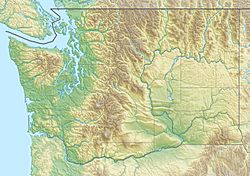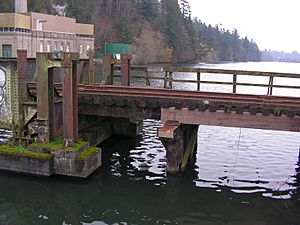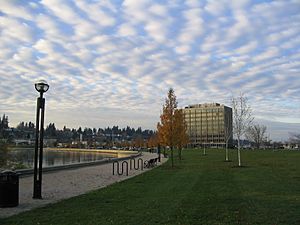Capitol Lake facts for kids
Quick facts for kids Capitol Lake |
|
|---|---|
 |
|
| Location | Olympia / Tumwater, Washington, United States |
| Coordinates | 47°1′59.81″N 122°54′31.58″W / 47.0332806°N 122.9087722°W |
| Type | Artificial lake, Formerly wetlands and estuary |
| Primary inflows | Deschutes River |
| Primary outflows | Budd Inlet |
| Max. length | 3 km (1.9 mi) |
| Surface area | 260 acres (1.1 km2) |
| Settlements | Tumwater, Olympia |
Capitol Lake is a human-made lake about 3 kilometers (1.9 miles) long. It covers about 260 acres (1.05 square kilometers). This lake is located where the Deschutes River meets the cities of Tumwater and Olympia in Washington State.
The famous Olympia Brewery sits right on Capitol Lake in Tumwater. It's just downstream from where the Tumwater Falls flow into the lake. The Washington State Department of Enterprise Services (DES) takes care of the lake. It's an important part of the Washington State Capitol Campus.
Contents
How Capitol Lake Was Created
Before American settlers arrived, the area where Capitol Lake is now was a natural tidal basin. This means it was a part of the ocean that filled with water during high tide and emptied during low tide. Native peoples used this area to gather shellfish.
After settlements grew in the mid-1800s, the basin became a place where wastewater from Olympia flowed. In the 1890s, the Northern Pacific Railroad built a train station and switching yard nearby.
Early Ideas for a Lake
The first idea to create Capitol Lake came in 1895. Leopold Schmidt, who owned the Olympia Brewing Company, suggested building a dam and locks. This would turn the tidal basin into a freshwater lake.
In 1911, a competition was held to design the State Capitol Campus. The winning architects, Wilder and White, had a big idea. They wanted to create a body of water that would reflect the beautiful Capitol buildings. They planned to do this by building a special gate, called a tidelock, at the mouth of the Deschutes River.
Another architect, John Charles Olmsted, also designed a lake. His idea was to build a raised path, or berm, to create the lake. This was different from the dam that was eventually built.
Making the Lake a Reality
In 1915, a plan to build a dam and locks was rejected. This plan would have created a lake very similar to Capitol Lake today. Businesses in Tumwater, like the Olympia Brewing Company, were against it at first. They worried it would affect their operations.
The Capitol buildings were built between 1913 and 1940. After that, the state focused on creating the reflecting lake. In 1937, the state started buying the private lands around the Capitol Campus. In 1941, Tumwater finally agreed to the plan.
In 1947, state lawmakers approved money to build the dam. This was largely due to hard work by legislators from Thurston County.
Before the dam, a small community called "Little Hollywood" existed along the Deschutes River. People living there threw trash directly into the river. This made the area look bad and was likely a health risk. Building the dam helped prevent this problem from happening again.
Capitol Lake was finally created in 1951 when the dam was finished. This dam held back the water from the Deschutes River, covering the old tide flats and forming the lake we see today.
Recent Developments
In the 1990s and 2000s, a park called Heritage Park was developed along the eastern side of Capitol Lake. It offers trails and views across the lake toward Puget Sound and the Olympic Mountains.
The 2001 Nisqually earthquake caused damage to the 4th Avenue Bridge and the Deschutes Parkway near the lake. Every July, a festival called Capital Lakefair is held, with many activities centered around Capitol Lake. There is also a popular trail around the lake that is about 1.5 miles long.
Future of Capitol Lake
For many years, there has been a discussion about changing Capitol Lake back into an estuary. An estuary is a place where a river meets the sea, and fresh water mixes with salt water.
In 2009, after years of scientific study, many groups agreed on a recommendation. The Department of Fish and Wildlife, Department of Ecology, Department of Natural Resources, Squaxin Island Tribe, and most Thurston County Commissioners suggested returning the Capitol Lake area to an estuary.
However, a problem arose: an invasive species called the New Zealand mud snail was found in the lake. These snails are very tiny, about the size of a grain of rice. Experts worried that if the lake was opened up, these snails could spread into Puget Sound and cause harm to the environment.
Biologist Howard Durrael said that efforts are being made to control the mud snail population. He stated that no major changes should happen around the lake until the snail population significantly decreases.
Because of a lot of silt (fine dirt and sand) building up, the lake has been cleaned out, or dredged, many times in the past. This helps keep the lake from filling in. In 2011, money was approved to start dredging again. This helps keep Capitol Lake looking as it was originally designed.
Invasive Species in Capitol Lake
An invasive species is a plant or animal that is not native to an area and can cause harm to the environment.
New Zealand Mud Snail
In 2009, the New Zealand mud snail was discovered in Capitol Lake. These tiny snails can multiply very quickly. Because of this, Capitol Lake has been closed to all public use, including boating and other fun activities, since 2009.
In 2013, a very cold winter, along with lowering the lake's water level, helped reduce the mud snail population. It was estimated that about 40-60% of the snails died.
Eurasian Milfoil
Another invasive plant, Eurasian milfoil, was found in the lake. In 2004, chemicals were used to control it. Later, scuba divers were used to remove this plant by hand.




